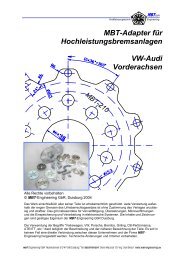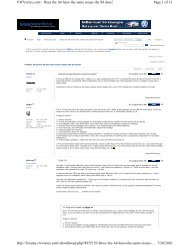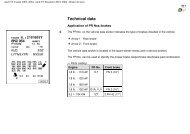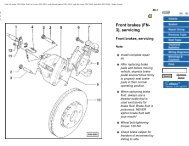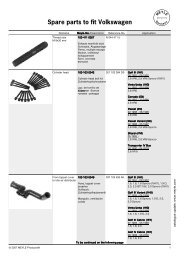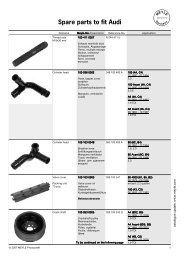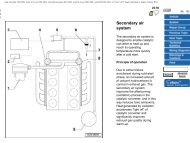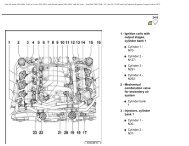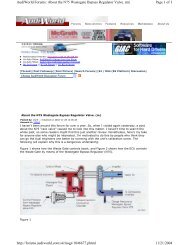VW MKII A2 MK2 Golf Jetta Fox Service Manual - VAGLinks.com
VW MKII A2 MK2 Golf Jetta Fox Service Manual - VAGLinks.com
VW MKII A2 MK2 Golf Jetta Fox Service Manual - VAGLinks.com
You also want an ePaper? Increase the reach of your titles
YUMPU automatically turns print PDFs into web optimized ePapers that Google loves.
4.3 Battery retaining clamp and bolt<br />
Refitting<br />
5 Refitting is a reversal of removal. Note the<br />
following:<br />
a) Ensure that the leads are fitted to their<br />
correct terminals<br />
b) Do not overtighten the lead clamp nuts or<br />
battery retaining clamp bolt<br />
c) Smear a little petroleum jelly on the<br />
terminals and clamps<br />
5 Alternator drivebelt -<br />
inspection and adjustment 2<br />
Refer to Chapter 1, Section 13<br />
7.2 Lead multi-plug and retaining clip<br />
(arrowed) - Bosch alternator<br />
8.3 Removing voltage regulator and brush<br />
assembly<br />
6 Alternator - testing<br />
5<br />
1 Accurate testing of the alternator is only<br />
possible using specialised instruments and is<br />
therefore best left to a qualified electrician.<br />
2 If the alternator is faulty, the condition of all<br />
brushes, soldered joints, etc., can be<br />
checked.<br />
3 If no fault is found, refit the alternator and<br />
have it checked professionally.<br />
7 Alternator - removal and<br />
refitting 3<br />
Starting and charging systems 5D•3<br />
Refitting<br />
6 Refitting is a reversal of removal. Before<br />
fully tightening the pivot and adjustment bolts,<br />
tension the drivebelt.<br />
8 Alternator - brush and voltage<br />
regulator renewal 3<br />
Bosch<br />
1 Disconnect the battery negative lead.<br />
2 Wipe clean the exterior surfaces of the<br />
alternator around the voltage regulator.<br />
3 Remove the two screws and withdraw the<br />
voltage regulator and brush assembly from<br />
the rear of the alternator (see illustration).<br />
4 Check that the length of the carbon<br />
brushes is not less than the minimum amount<br />
Removal<br />
specified (see illustration).<br />
1 Disconnect the battery negative lead. 5 If the brushes are serviceable, clean them<br />
2 Release the clip and pull the multi-plug with a solvent-moistened cloth.<br />
from the rear of the alternator (see 6 Check that brush spring pressure is equal<br />
illustration).<br />
for both brushes and holds the brushes<br />
3 Loosen the pivot and adjustment bolts (see securely against the slip rings. If in doubt<br />
illustration) then push the alternator in about the condition of the brushes and<br />
towards the engine and slip the drivebelt from springs, <strong>com</strong>pare them with new items.<br />
the alternator.<br />
7 If the brushes are over worn, unsolder the<br />
4 Remove the adjustment link nut and brush leads and remove the brushes. Clean<br />
washer.<br />
the housing, insert the new brushes and<br />
5 Support the alternator then remove the solder the new leads into position.<br />
pivot bolt and withdraw the unit from the 8 Clean the slip rings with a solvent-<br />
engine.<br />
moistened cloth, then check for signs of<br />
scoring, burning or severe pitting. If worn or<br />
damaged, the slip rings should be attended to<br />
by an auto-electrician.<br />
9 Reassembly is a reversal of the dismantling<br />
procedure.<br />
Motorola<br />
10 This procedure is similar to that described<br />
for the Bosch alternator. Identify the regulator 5D<br />
wires for position before disconnecting them<br />
(see illustration).<br />
7.3 Alternator pivot bolt and bracket –<br />
1.3 litre<br />
8.4 Checking alternator brush length 8.10 Voltage regulator/brush unit removal<br />
1081 <strong>VW</strong> <strong>Golf</strong> & <strong>Jetta</strong>



